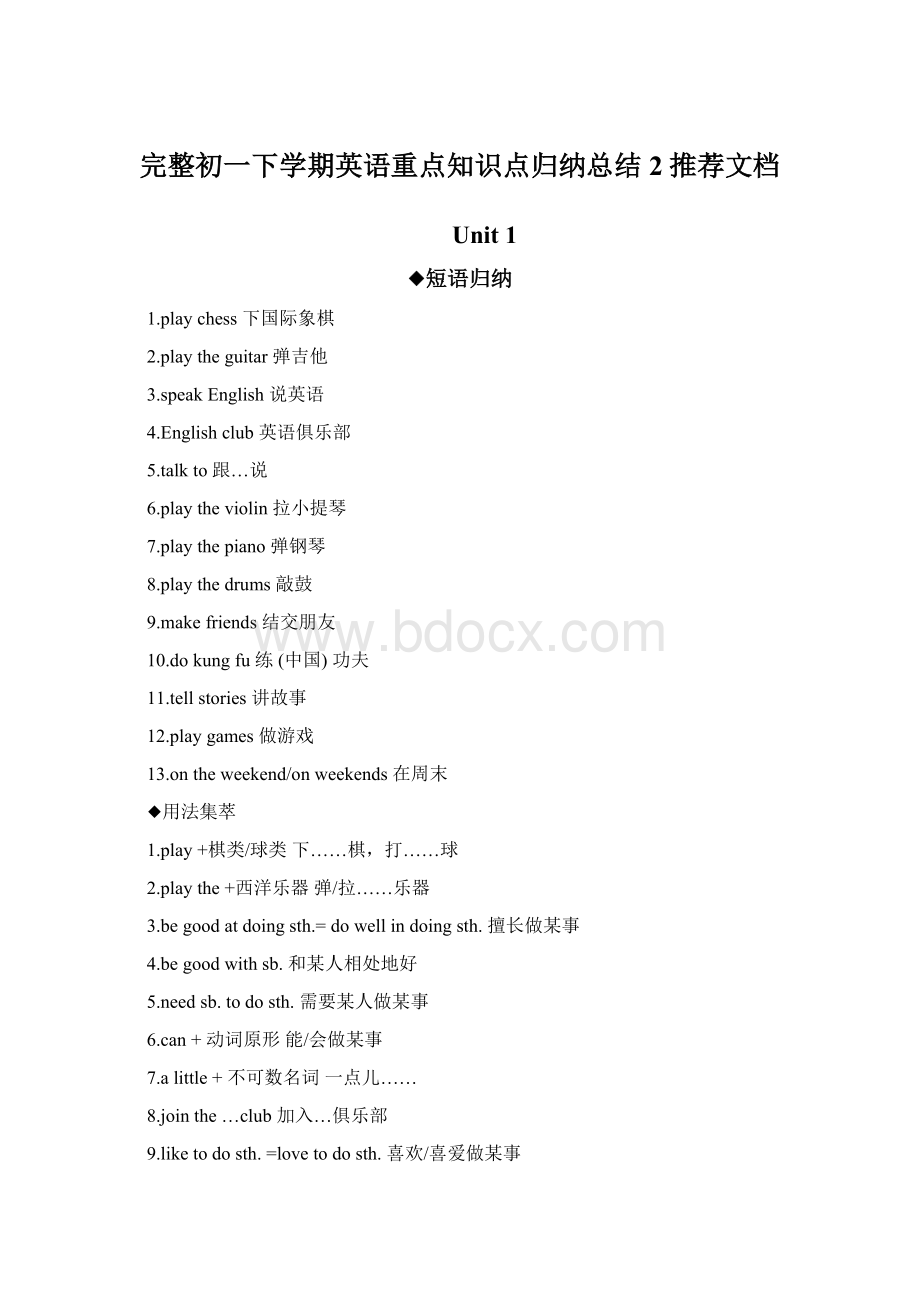完整初一下学期英语重点知识点归纳总结2推荐文档Word文档下载推荐.docx
《完整初一下学期英语重点知识点归纳总结2推荐文档Word文档下载推荐.docx》由会员分享,可在线阅读,更多相关《完整初一下学期英语重点知识点归纳总结2推荐文档Word文档下载推荐.docx(35页珍藏版)》请在冰豆网上搜索。

◆话题写作
DearSir,
Iwanttojoinyourorganization(组织)tohelpkidswithsports,musicandEnglish.MynameisMike.Iam15yearsold.I’mastudentinNo.1Middleschool.Icanplaytheguitarwell.Icansingmanysongs.IcanswimandspeakEnglishwell,too.IthinkIcanbegoodwiththekids.Ialsodowellintellingstories.
Ihopetogetyourlettersoon.
Yours,Mike
◆语法讲解
1.can+动词原形,它不随主语和数而变化。
(1)含有can的肯定句:
主语+can+谓语动词的原形+其他。
(2)变一般疑问句时,把can提前:
Can+主语+动词原形+其他?
肯定回答:
Yes,主语+can。
否定回答:
No,主语+can'
t.
(3)含有can的否定句:
主语+can'
t+动词的原形+其他。
(4)含有can的特殊疑问句:
特殊疑问词+can+主语+动词原形+其他?
2.may+动词的原形。
(may为情态动词)一般疑问句是把may提前,肯定回答是:
Yes,主语+may。
否定回答是:
No,主语+mustn'
t。
或please
don'
join+某个组织,俱乐部,party,参军,党派等“加入”
Joinsb.“参加到某人中”joinin(doing)sth“加入做......,参加某个活动”Joinin=takepartin+活动,比赛
3.说某种语言:
speak+语言
4、play+球、棋、牌;
play+the+乐器。
5、擅长于(做)什么:
begoodat+名词/动ing
6、帮助某人做某事:
helpsb.(to)dosth.helpsb.withsth.7、我能知道你名字吗?
MayIknowyourname?
8、想要做什么:
wanttodosth例如:
Iwanttolearnaboutart.9、Whatclubdoyouwanttojoin?
Iwanttojointhechessclubandthebasketballclub.
10、WhatclubdoesTomwanttojoin?
Hewantstojointheswimmingclub.11、Hecan’tplaytheviolinorthepiano.Canyouhelpkidswithswimming?
12、WhydoyouwanttojointheEnglishclub?
BecauseIwanttolearnEnglishwell.
Unit2
1.whattime几点
2.gotoschool去上学
3.getup起床
4.takeashower洗淋浴
5.brushteeth刷牙
6.getto到达
7.dohomework做家庭作业
8.gotowork去上班
9.gohome回家
10.eatbreakfast吃早饭
11.getdressed穿上衣服
12.gethome到家
13.either…or…要么…要么…
14.gotobed上床睡觉
15.inthemorning/afternoon/evening在上午/下午/晚上
16.takeawalk散步
17.lotsof=alotof许多,大量
18.radiostation广播电台
19.atnight在晚上
20.belatefor=arrivelatefor迟到
1.at+具体时间点在几点(几分)
2.eatbreakfast/lunch/dinner吃早饭/午饭/晚饭
3.thirty\halfpast+基数词……点半
4.fifteen\aquarterto+基数词差一刻到……点
5.takea/an+名词从事……活动
6.from…to…从……到……
7.needtodosth需要做某事
1.Whattimedoyouusuallygetup?
Iusuallygetupatsixthirty.
2.That’safunnytimeforbreakfast.
3.Whendostudentsusuallyeatdinner?
Theyusuallyeatdinnerataquartertosevenintheevening.
4.Intheevening,IeitherwatchTVorplaycomputergames.
5.Attwelve,sheeatslotsoffruitandvegetablesforlunch..
6.Sheknowsit’snotgoodforher,butittastesgood.
7.Hereareyourclothes.
主题:
谈论日常作息习惯
MySchoolDay
Iamastudent.Iusuallygetupatseven,andIeatbreakfastatseventhirty.ThenIgotoschoolateight.Schoolstartsateightthirty.Ieatlunchattwelve.Igohomeat17:
00.Iofteneatdinnerat19:
00andthenplaythepiano.Idomyhomeworkat20:
00.At22:
00,Igotobed.
1.whattime和when引导的特殊疑问句。
(1)对时间提问用whattime,也可以用when。
询问钟点时用whattime,询问日期、月份、年份时用when。
(2)询问做某事的时间时,两者可以互换。
(3)其他询问时间的句子:
What'
sthetime?
=Whattimeisit?
现在几点了?
时刻表达法:
顺读法和逆读法。
(1)顺读法:
“钟点+分钟”直接读数字。
(2)逆读法:
借助介词past或to表示,要先说分再说钟点。
A.当分钟不超过30分钟时(包括30分钟),即<
或=30,用past表示。
其结构为:
“分钟
+past+整点”意为“几点过几分”。
B.当超过30分钟时,即>
30,用to表示。
“所差分钟(即60—所过分钟数)
+to+下一个整点”,to译成“差”,差几分钟到几点。
C.当分钟为30分钟用half表示,当分钟为15分钟用aquarter。
2.always总是>
usually通常>
often常常>
sometime有时
3.Watch+TV、球赛“观看,观赏”,特指长时间注视。
See+电影、医生“看见”,强调看的结果。
Look“看”,强调看的动作,look后接宾语时要用介词at。
Read+书刊、杂志“阅读”
4.listento+宾语
5.Goto+地点名词如:
gotoschoolgo+地点副词如:
gohome6、Takeashower“淋浴”
7、Eatbreakfast吃早餐
Unit3
1.gettoschool到达学校
2.takethesubway乘地铁
3.rideabike骑自行车
4.howfar多远
5.fromhometoschool从家到学校
6.everyday每天
7.takethebus乘公共汽车
8.bybike骑自行车
9.busstop公共汽车站
10.thinkof认为
11.between…and…在…和…之间
12.one11-year-oldboy一个11岁的男孩
13.playwith…和…玩
etrue实现
15.haveto不得不
1.take…to…=goto…by…乘…去…
2.Howdo/does(sb)getto…?
…是怎样到…的?
3.Howfarisitfrom…to…?
从…到…有多远?
4.Ittakessb.sometimetodosth.做某事花费某人多长时间。
5.Howlongdoesittaketodosth.?
…花费多长时间?
6.Itis+adj.+todosth.做某事是….
7.Thanksfor+n./Ving感谢你(做)某事。
1.Howdoyougettoschool?
Iridemybike.
2.Howfarisitfromyourhometoschool?
3.Howlongdoesittakeyoutogettoschool?
4.Formanystudents,itiseasytogettoschool.
5.Thereisaverybigriverbetweentheirschoolandthevillage.
上学的交通方式写作思路:
开篇点题:
点出自己的出行方式;
具体内容:
自
己选择这种交通方式的原因;
结束语:
表明自己的观点。
TheBestWayforMetoGotoSchool
Differentstudentsgotoschoolindifferentwaysinourschool,butIlliketogotoschoolonfoot.First,Iliveneartheschool,somyhomeisnotfarfrommyschool.Andittakesmeafewminutestogetthere.Second,thereisacrossingonmywaytoschool,andsometimesthetrafficisverybusy.Ithinkitissafertogotoschoolonfoot.Third,Ithinkwalkingisgoodformyhealth.It’sakindofsportanditmakesmestudybetter.
Soinmyopinion,thebestwaytogotoschoolisonfoot.Whataboutyou?
(一)how引导的特殊疑问句
1.how引导的特殊疑问句提问交通方式,其答语分三种情况:
a.takea/an/the+交通工具(单数)
b.by+交通工具(单数)
c.on/in+限定词+交通工具
2.howfar用来提问距离,多远,其答语分为两种:
(1)用长度单位表示:
Itisfivekilometers.
(2)用时间表示:
It’stwentyminutes’walk.
3.howlong用来提问时间,意为多久回答常用“for+段时”。
----HowlonghaveyoulearntEnglish?
----For3years.
howsoon用来提问做完某事还需要多长时间,常用于将来时态时,常用“in+时间段”来回答。
――HowsoonwillyouarriveinBeijing?
----In3hours.
二、重点知识详解
1.take+a/an/the+表示交通工具的名词,乘……去某地,是动词短语,在句中作谓语。
Hetakesthetrain.
takethesubway乘地铁takeawalk散步take
ashower洗个澡takearest休息一会takeaseat坐下
takesomemedicine吃药
2.by+表示交通工具的单数名词或on/in+a/an/the/one’s+表示交通工具的单数名词,是介词短语作方式状语。
Igettoschoolbybike.=Igettoschoolonmybike.3.walk/ride/drive/fly+to+地点名词,步行/骑自行车/开车/坐飞机去某地表示乘交通工具方式可以互换表达相同的意义:
Takethebustoschool=gotoschoolbybus=gotoschoolonabusDriveacartowork=gotoworkbycar=gotoworkinacar
Flytoshanghai=gotoshanghaibyplane/air=takethe/aplanetoshanghai=gotoshanghaiona/an/theplane.
4.get表示“到达”,后接名词需加to,接地点副词不加to.reach给示到达,是及物动词,其后直接接宾语。
arrivein+大地点arriveat+小地点后接副词不需介词。
5.Ittakessbsomemoney/timetodosth.花费某人多少时间/钱做某事Sbpaysomemoneyforsth某人为某物花费多少钱
Sbspendsometime/moneyonsth某人在做某事或某物上花费时间/钱Sbspendsometime/money(in)doingsth
Sthcostsbsomemoney某物花费某人多少钱
6.HowfarisitfromAtoB?
=HowfarisBfromA?
答语有两种:
It’s…meters/miles/kilometers(away)有……米/英里/千米(远)
It‘sabouttenminutes’walk/ride.大约有十分钟步行/骑车的路程。
7.haveto后加动词原形,侧重客观的需要,有“不得不,被迫”之意,有多种时态形式,否定式为don’thaveto(needn’t)意为“不必”。
Must侧重于说话者的主观看法,认为有必要或有义务做某事,只有现在时一种形式,否定式must’t意为“一定不要,不允许,禁止”反意词为“needn’t”。
8.感谢用语:
Thankyouverymuch,Thanksalot,Manythanks.
回答感谢用语的句子:
That’sok/allright.不用谢。
Youarewelcome不客气。
Itismypleasure./Mypleasure./Itisapleasure.不客气、那是我的荣幸。
/Don’tmentionit。
别在意。
Itwasnothingatall.那没什么。
Unit4
1.ontime准时,按时
2.listento…听……
3.inclass在课上
4.belatefor做……迟到
5.haveto不得不
6.bequiet安静
7.goout外出
8.dothedishes清洗餐具
9.makebreakfast做早饭
10.make(one’s)bed铺床
11.benoisy吵闹
12.keepone’shairshort留短发
13.playwithsb.和某人一起玩
14.playthepiano弹钢琴
15.havefun玩得高兴
16.makerules制订规则
1.Don’t+动词原形+其他,不要做某事。
2.helpsb.(to)dosth.帮助某人做某事
3.toomany+可数名词复数太多的……
4.practicedoingsth.练习做某事
5.bestrictwithsb.对某人要求严格
6.bestrictinsth.对某事要要求严格
7.leavesthsp.把某物忘在某地
8.keep+宾语+形容词使……保持某种状态
9.learntodosth.学会做某事
10.havetodosth.不得不做某事
1.Don’tarrivelateforclass.上课不要迟到。
2.Canwebringmusicplayerstoschool?
我们可以带音乐播放器到学校吗?
3.Andwealwayshavetoweartheschooluniform.并且我们总是不得不穿校服。
4.Therearetoomanyrules!
有太多的规则!
5.Don’tleavethedirtydishesinthekitchen!
不要把脏盘子留在厨房里!
6.Ihavetokeepmyhairshort.我不得不留短发。
DearTom,
Thanksforyourlastletter.Youwanttoknowtherulesinourschool.Nowletmetellyouaboutthem.
Wecan’tarrivelateforclass.Wecan’ttalkloudlyinclass.Weshouldkeepquiet.Whenwemeetourteachersonourway,weshouldsayhellotothem.Wecan’teatordrinkinclass,andwecan’tlistentomusicorplaygamesinclass.
Ithinkwehavetoomanyrules.Whataboutyours?
Pleasewriteandtellme.
Yours,LiMing
◆语法
肯定的祈使句:
(1)实义动词原形+其他;
(2)be动词原形+形容词+其他;
(3)Letsbdosth.
否定的祈使句:
(1)Don’t+实义动词+原形;
(2)Don’tbe+形容词+其他;
(3)Don’tletsbdosth
(4)No+Ving.
2.不要迟到:
Don’tarrivelate.=Don’tbelate.(arrive=be)
上课/上学不要迟到:
Don’tarrive(be)lateforclass/school.
3.主语省略(无主语):
Don’tarrivelateforclass.
主语不省略(有主语):
Wecan’tarrive;
ateforclass.
4.在学校我们必须穿校服:
Wehavetowearuniformsatschool.
句型:
不得不/必须做某事:
havetodosth
否定:
不必做某事:
don’thavetodosth
穿校服:
单数:
wearauniform复数:
wearuniforms
5.在我家里有太多的规矩:
Ihavetoomanyrulesinmyhouse.
词组:
太多…:
toomany…
6.我从来没有任何快乐:
Ineverhaveanyfun.
(never译为“从来没有”,表示否定,否定句中表示“任何,一些”,用any)
7.不要大声说话:
Don’ttalkloudly.
请大声说:
Speakloudly,please.
8.他擅长于唱歌:
Heisgoodatsinging.
擅长于做某事:
begoodatdoingsth
9.表示“地点”的词组:
(1)在教室里:
intheclassroom
在课堂上:
inclass
(2)在走廊上:
inthehallways
在学校里: